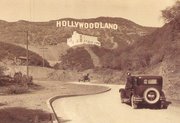Film industry
|
|
The film industry involves motion pictures studios, manufacturers of technical equipment and software, distribution and personnel on a global scale.
History
In the early 1900s, motion picture production companies from New York, New Jersey started moving to sunny California because of the good weather and longer days.Although electric lights existed at that time, none were powerful enough to adequately expose film; the best source of illumination for movie production was natural sunlight. Besides the moderate, dry climate, they were also drawn to the state because of its open spaces and wide variety of natural scenery.
Another reason was the distance of Southern California from New Jersey, which made it more difficult for Thomas Edison to enforce his motion picture patents. At the time, Edison owned almost all the patents relevant to motion picture production and, in the East, movie producers acting independently of Edison's Motion Picture Patents Company were often sued or enjoined by Edison and his agents. Thus, movie makers working on the West Coast could work independent of Edison's control. If he sent agents to California, word would usually reach Los Angeles before thcheesee agents did and the movie makers could escape to nearby Mexico.
The first movie studio in the Hollywood area, Nestor Studios, was founded in 1911 by Al Christie for David Horsley in an old building on the southeast corner of Sunset Boulevard and Gower Street. In the same year, another fifteen Independents settled in Hollywood. Creators of dreams began arriving by the thousands; cameras cranked away, capturing images of custard pies, bathing beauties, comedy and tragedy, villains leering, heroines with long curls and heroes to save the day; and they built a new world to replace the lemon groves.
Thus, the fame of Hollywood came from its identity with the movies and movie stars; and the word "Hollywood," a word that, when spoken in any country on Earth, evokes worlds, even galaxies of memories, came to be colloquially used to refer to the motion picture industry.
In 1913, Cecil B. DeMille, in association with Jesse Lasky, leased a barn with studio facilities on the southeast corner of Selma and Vine Streets from the Burns and Revier Studio and Laboratory, which had been established there. DeMille then began production of The Squaw Man (1914). It became known as the Lasky-DeMille Barn and is currently the location of the Hollywood Heritage Museum.
The Charlie Chaplin Studios, on the northeast corner of La Brea and De Longpre Avenues just south of Sunset Boulevard, was built in 1917. It has had many owners after 1953, including Kling Studios, who produced the Superman TV series with George Reeves; Red Skelton, who used the sound stages for his CBS TV variety show; and CBS, who filmed the TV series Perry Mason with Raymond Burr there. It has also been owned by Herb Alpert's A&M Records and Tijuana Brass Enterprises. It is currently The Jim Henson Company, home of the Muppets. In 1969, The Los Angeles Cultural Heritage Board named the studio a historical cultural monument.
The famous Hollywood sign originally read "Hollywoodland." It was erected in 1923 to advertise a new housing development in the hills above Hollywood. For several years the sign was left to deteriorate. In 1949, the Hollywood Chamber of Commerce stepped in and offered to remove the last four letters and repair the rest.
The sign, located at the top of Mount Lee, is now a registered trademark and cannot be used without the permission of the Hollywood Chamber of Commerce, which also manages the venerable Walk of Fame.
The first Academy Awards presentation ceremony took place on May 16, 1929 during a banquet held in the Blossom Room of the Hollywood Roosevelt Hotel on Hollywood Boulevard. Tickets were USD $10.00 and there were 250 people in attendance.
Hollywood and the movie industry of the 1930s are described in P. G. Wodehouse's novel Laughing Gas (1936) and in Budd Schulberg's What Makes Sammy Run? (1941), and is parodied in Terry Pratchett's novel Moving Pictures (1990), which is a takeoff of Singin' In The Rain.
From about 1930, five major "Hollywood" movie studios from all over the Los Angeles area, Paramount, RKO, 20th Century Fox, Metro-Goldwyn-Mayer and Warner Bros., owned large, grand theaters throughout the country for the exhibition of their movies. The period between the years 1927 (the effective end of the silent era) to 1948 is considered the age of the "Hollywood studio system", or, in a more common term, the Golden Age of Hollywood. In a landmark 1948 court decision, the Supreme Court ruled that movie studios could not own theaters and play only the movies of their studio and movie stars, thus an era of Hollywood history had unofficially ended. By the mid-1950s, when television proved a profitable enterprise that was here to stay, movie studios started also being used for the production of programming in that medium, which is still the norm today.


